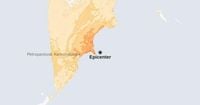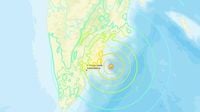In the early hours of Friday, September 19, 2025, a powerful magnitude 7.8 earthquake struck the Petropavlovsk-Kamchatsky region in Russia’s Far East, sending shockwaves through one of the world’s most seismically active zones. According to the U.S. Geological Survey (USGS), the quake was centered about 80 miles east of Petropavlovsk-Kamchatsky at a shallow depth of 10 kilometers (6.2 miles), a factor that often amplifies shaking felt on the surface. The event was recorded at around 3 p.m. Eastern Time on Thursday, highlighting just how interconnected global monitoring systems have become.
Within moments of the quake, emergency services in Kamchatka were placed on full alert. The region’s governor, Vladimir Solodov, took to the Telegram messaging app to urge calm and inform residents of the immediate tsunami warning issued for the peninsula’s eastern coast. “This morning is once again testing the resilience of Kamchatka residents,” Solodov wrote. “There are currently no reports of damage. I ask everyone to remain calm … A tsunami warning has been issued for the east coast of the peninsula. The public is being alerted.” His words, reported by news.com.au, reflected both the anxiety and preparedness that define life in this seismically volatile region.
Videos quickly surfaced on Russian social media, showing furniture and light fixtures shaking violently in homes, while cars rocked back and forth on city streets. Shocked residents could be seen rushing out of their buildings, many still in pajamas, uncertain if further tremors would follow. And indeed, they did: at least nine aftershocks were reported, ranging from magnitude 4.6 to 5.8, according to Russia’s state geophysical service. The largest aftershocks kept nerves frayed and emergency crews on standby throughout the day.
Authorities wasted no time issuing tsunami warnings for not just Kamchatka, but also for parts of the Kuril island chain north of Japan. The U.S. National Weather Service and the Pacific Tsunami Warning Center issued advisories for Alaska’s Aleutian Islands and Amchitka Pass, cautioning that small waves might reach those shores. However, these advisories were cancelled within a couple of hours, as further data confirmed there was no risk of a destructive, Pacific-wide tsunami. “There is no tsunami threat to Hawaii,” NOAA and the National Weather Service’s U.S. Tsunami Warning System confirmed. “A destructive Pacific-wide tsunami is not expected.”
Despite the magnitude and shallow depth of the earthquake, the immediate region was spared the worst. There were no confirmed reports of fatalities or major structural damage. A USGS graphic, as shown by Newsweek, estimated economic losses from the quake could reach between ten million and up to a billion dollars—representing up to 1 percent of Russia’s GDP—but the damage was expected to be relatively localized. Another USGS map revealed that around 241,000 people experienced strong shaking, with 33,000 feeling moderate tremors and 11,000 reporting light shaking. Yet, crucially, no one reported very strong or severe shaking, and the likelihood of casualties was assessed as low.
Petropavlovsk-Kamchatsky and the wider Kamchatka Peninsula are no strangers to seismic drama. The region sits atop the notorious Ring of Fire—an arc of tectonic boundaries encircling the Pacific Ocean—where the Pacific Plate grinds against the North American Plate. This geological setup makes Kamchatka one of the most earthquake-prone places on Earth. The Aleutian megathrust fault, a major subduction zone running from Russia to Alaska, is the primary culprit behind the region’s seismicity. According to the Alaska Earthquake Center, this fault has produced some of the strongest earthquakes in recorded history.
Indeed, the September 19 event came on the heels of a string of significant quakes in the region. Just two months earlier, on July 29, 2025, a massive magnitude 8.8 earthquake struck off Kamchatka’s eastern coast. That seismic jolt triggered widespread tsunami warnings across the Pacific, with authorities in Kamchatka reporting waves of three to four meters in some areas. Evacuations were ordered in multiple coastal settlements, including Severo-Kurilsk, and residents scrambled to higher ground. Japan’s Meteorological Agency warned of potential tsunami waves up to three meters along its Pacific coast, and even portions of the U.S. West Coast were put on advisory. The July quake was the largest in Russia since 2011 and tied as the sixth-largest ever recorded globally since modern records began.
In contrast, the September 19 quake, while powerful, did not unleash a major tsunami. The Pacific Tsunami Warning Center stated there was no risk that the event would trigger a Pacific-wide tsunami, and the U.S. National Weather Service stressed that there was no destructive threat to Hawaii or the broader Pacific basin. People in affected U.S. regions were advised to stay out of the water due to possible strong currents, but the all-clear was given within hours. The quick response and cancellation of warnings underscored the improvements in global seismic and tsunami monitoring systems since the devastating tsunamis of the past.
For residents of Kamchatka, these events are a reminder of the region’s ever-present geological risks. The peninsula’s dramatic volcanic peaks and rugged coastline are the product of centuries of tectonic upheaval. The 1952 Kamchatka earthquake, for instance, generated Pacific-wide tsunami waves, including 30-foot surges in Hawaii. More recently, the 2011 Tōhoku earthquake in Japan and the 2004 Sumatra-Andaman event both underscored the catastrophic potential of offshore megathrust quakes.
Earthquakes of this magnitude are not just natural phenomena—they shape the lives, economies, and histories of the communities they strike. The people of Kamchatka, accustomed to the ground shifting beneath their feet, have developed a resilience and preparedness that is both remarkable and necessary. Governor Solodov’s call for calm and the rapid mobilization of emergency services reflect a hard-earned familiarity with disaster response. Yet, as the world watched and waited for news of damage or casualties, the region was fortunate this time: the earth shook, the sea remained largely still, and life, with a few shaken nerves, carried on.
As seismic activity continues to ripple through the Pacific’s Ring of Fire, Kamchatka’s experience this September offers a sobering reminder of the planet’s restless energy—and the vigilance required to live safely on its shifting crust.





